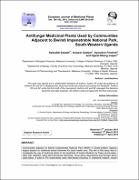| dc.contributor.author | Esezah, Kakudidi | |
| dc.contributor.author | Anywar, Godwin | |
| dc.contributor.author | Ayorekire, Fredrick | |
| dc.contributor.author | Ogwal-Okeng, Jasper | |
| dc.date.accessioned | 2019-10-31T13:46:07Z | |
| dc.date.available | 2019-10-31T13:46:07Z | |
| dc.date.issued | 2015 | |
| dc.identifier.citation | Esezah, K., Godwin, A., Fredrick, A., & Ogwal-Okeng, J. (2015). Antifungal medicinal plants used by communities adjacent to Bwindi impenetrable National Park, South Western Uganda. Eur J Med Plants, 7, 184-92. | en_US |
| dc.identifier.issn | 2231-0894 | |
| dc.identifier.uri | https://hdl.handle.net/123456789/88 | |
| dc.description.abstract | Communities adjacent to Bwindi Impenetrable National Park (BINP) in South-western Uganda
largely depend on traditional herbal treatment for basic health care. The aim of this study was to
investigate the use of medicinal plants in the treatment of fungal infections by these communities.
Data was collected using semi-structured interviews, focus group discussions and through direct
observation. A total of 415 respondents were interviewed including 71 traditional healers, herbal
medicine traders and health workers. Twenty six medicinal plants belonging to 16 families were
documented. Fabaceae with four species, Asteraceae Lamiaceae and Solanaceae each with three
species. Eight different fungal infections were identified. The commonest fungal infection was Tinea
corporis (44.3%), while the least common fungal infection was Tinea unguium (1.2%). Eighty-six
percent of the respondents reported that they had ever suffered from at least one fungal infection.
Out of these, 72% had exclusively used herbal medicine for treatment, while 28% had used both
herbal and western medicine for treatment. Pentas longiflora, Tetradenia riparia, Erucastrum
arabicum, Erigeron floribundus and Coleus latifolius were ranked as highly effective plants by the
traditional healers. Leaves (78.6%) were the most commonly used parts. Female herbalists were
more involved in conservation by cultivating the medicinal plant species than men. The use of
several plant species provides alternatives when others are not available. Fungal infections are
common and most of the respondents exclusively use herbal medicine to treat fungal infections | en_US |
| dc.language.iso | en | en_US |
| dc.publisher | European Journal of Medicinal Plants | en_US |
| dc.subject | Fungal infections | en_US |
| dc.subject | medicinal plants | en_US |
| dc.subject | Bwindi | en_US |
| dc.subject | Uganda | en_US |
| dc.title | Antifungal Medicinal Plants Used by Communities Adjacent to Bwindi Impenetrable National Park, South-Western Uganda | en_US |
| dc.type | Article | en_US |

